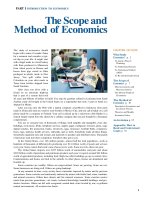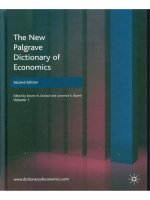Money and government the past and future of economics
Bạn đang xem bản rút gọn của tài liệu. Xem và tải ngay bản đầy đủ của tài liệu tại đây (5.03 MB, 513 trang )
Money and Government
This page intentionally left blank
robe rt s ki d e l s k y
Money and Government
The Past and Future of Economics
New Haven and London
First published in the United States in 2018 by Yale University Press.
First published in the United Kingdom in 2018 by Penguin Books Ltd., London,
as Money and Government: A Challenge to Mainstream Economics.
Copyright © 2018 by Robert Skidelsky. The moral right of the author has
been asserted. All rights reserved.
This book may not be reproduced, in whole or in part, including illustrations, in any form
(beyond that copying permitted by Sections 107 and 108 of the U.S. Copyright Law and
except by reviewers for the public press), without written permission from the publishers.
Yale University Press books may be purchased in quantity for educational, business, or
promotional use. For information, please e-mail (U.S. office) or sales@
yaleup.co.uk (U.K. office).
Typeset in 10.5/14 pt Sabon LT Std by Jouve (U.K.), Milton Keynes.
Printed in the United States of America.
Library of Congress Control Number: 2018954397
ISBN 978-0-300-24032-0 (hardcover : alk. paper)
This paper meets the requirements of ANSI/NISO Z39.48-1992
(Permanence of Paper).
10
9
8
7
6
5
4
3
2
1
To students of political economy, young and old
This page intentionally left blank
Contents
List of Figures
Preface
Introduction
xiii
xvii
1
i. Unsettled Issues
1
ii. The Culprits
4
iii. A Brief Sketch of the Book
8
Appendix I.1: Ideas, Vested Interests and Cycles
11
Pa r t On e
History of Economic Thought
1. The Mysteries of Money: A Short History
19
21
i. The Classical Dichotomy
21
ii. The Origins of Money
23
iii. The Value of Money
25
iv. Creditors and Debtors
27
v. The Origins of the Quantity Theory of Money
32
vi. The Demand for Money
35
vii. Money, the Great Deceiver
36
viii. Conclusion
38
2. The Fight for the Gold Standard
i. Prelude to the Gold Standard: the British
Recoinage Debate of the 1690s
40
41
ii. Nineteenth-century Monetary Debates: An Overview 44
iii. Bullionists versus the ‘Real Bills’ Doctrine
45
iv. Currency School versus Banking School
49
vii
C on t e n t s
v. Bimetallism
50
vi. How Did the Gold Standard Actually Work?
3. The Quantity Theory of Money:
From History to Science
52
60
i. The Quantity Theory of Money: The
Two Branches
60
ii. Fisher’s Santa Claus
62
iii. Knut Wicksell’s Credit Money version
of the QTM
67
iv. Was Wicksell a Quantity Theorist?
70
v. Conclusion
71
Appendix 3.1: Fisher’s Equation
4. Theories of the Fertile and Barren State
71
73
i. Introduction
73
ii. The Fertile State of the Mercantilists
77
iii. The Wasteful State of the Political Economists
81
iv. The Victorian Fiscal Constitution
85
v. The Persistence of Mercantilism
88
vi. Conclusion
93
Pa r t T wo
The Rise, Triumph and Fall of Keynes
5. Keynes’s Intervention
95
99
i. The Trouble with Money
99
ii. The Problem with Fiscal Policy
106
iii. The Macmillan Committee
114
iv. The General Theory of Employment,
Interest, and Money
117
v. Policy Implications
124
vi. Conclusion
129
viii
C on t e n t s
Appendix 5.1: Contrast Between the Classical
and Keynesian Models
132
Appendix 5.2: The Fiscal Multiplier
133
6. The Keynesian Ascendancy
137
i. Keynesianism Ascendant
137
ii. Full Employment Keynesianism: 1945–60
141
iii. Growth Keynesianism: 1960–70
148
iv. Reasons for the Strength of the Boom
154
v. Stagflation Keynesianism: 1970–76
162
vi. Great Britain: the End of the Keynesian Road
7. The Theory and Practice of Monetarism
167
171
i. Keynes and the Classics
172
ii. The Neo-classical Synthesis
173
iii. The Emergence of the Counter-orthodoxy
174
iv. Monetarism
176
v. The Monetarist Experiment: 1976–85
184
vi. Monetarism’s Fiscal Legacy
190
vii. From Friedman to the New Consensus: 1985–2008 194
viii. Conclusion
201
Appendix 7.1: IS/LM, the Keynesian
Teaching Tool
203
Appendix 7.2: The Modelling of Expectations
205
Appendix 7.3: The Central Bank Reaction
Function
212
Pa r t T h r e e
Macroeconomics in the Crash and After, 2007–
8. The Disablement of Fiscal Policy
215
221
i. The Fiscal Crisis of the State
221
ii. The British Debate
225
ix
C on t e n t s
iii. Austerity: A Comparative Assessment
241
iv. Conclusion
244
Appendix 8.1: Monetary Financing of the
Deficit
9. The New Monetarism
246
248
i. Pre-crash Monetary Orthodoxy
249
ii. Why Quantitative Easing?
253
iii. Quantitative Easing Programmes, 2008–16
256
iv. How was QE Meant to Work?
258
v. Assessment
263
vi. Conclusion
277
Appendix 9.1: A Note on Tim Congdon
10. Distribution as a Macroeconomic Problem
279
288
i. The Indifference of Mainstream Theory to Inequality 288
ii. The Microeconomics of Distribution
290
iii. Distribution and the Macroeconomy
293
iv. The Modern Under-consumptionist Story
298
v. Conclusion
305
11. What Was Wrong with the Banks?
307
i. Pre-crash Orthodoxy
308
ii. Theory
310
iii. Understanding Banking: Some Essential Terms
316
iv. Loosening the Regulatory Noose
318
v. Financial Innovation
322
vi. Conclusion
327
Appendix 11.1: Why Didn’t the Credit Ratings
Agencies Do Their Job?
12. Global Imbalances
329
331
i. Introduction
331
ii. A Pre-crash Bird’s-eye View
334
x
C on t e n t s
iii. Some Basic Theory
335
iv. Current Account Imbalances as a
Cause of Meltdown?
336
v. Saving Glut versus Money Glut
338
vi. Banking Imbalances
342
vii. Conclusion
343
Pa r t Fou r
A New Macroeconomics
13. Reinventing Political Economy
345
347
i. Introduction
347
ii. What Should Governments Do and Why?
349
iii. A New Macroeconomic Constitution
351
iv. The Inflation Problem
358
v. Making Banking Safe
361
vi. Inequality
368
vii. Hyper-globalization and its Discontents
371
viii. Reforming Economics
384
Notes
Bibliography
Index
391
427
461
xi
This page intentionally left blank
Figures
1. Beliefs of the hard and soft money schools
39
2. Four key monetary debates
40
3. The price history of Britain, 1873–1896
51
4. The Cunliffe Mechanism
54
5. Leijonhufvud’s circular flow diagram
68
6. UK public spending as a proportion of GDP, 1692–2015
77
7. UK public debt as a proportion of GDP, 1692–2015
77
8. The rise and fall of UK war debt, 1700–1914
86
9. UK unemployment through to the Second World War
97
10. Unemployment rates, 1929–1938
112
11. Keynes’s short-run supply and demand curve
132
12. GDP per capita growth in interwar years, Keynesian
Age and post-1975
154
13. UK public sector net investment, current budget deficit
and net borrowing, 1956–2014
156
14. UK public spending and tax revenue, 1950–2000
157
15. The discomfort index in the OECD, 1959–1976
163
16. UK monetary policy and inflation, 1970–2009
189
17. Oil prices and UK CPI inflation, 1970–1985
189
18. The Laffer curve
191
19. IS-LM model
203
20. Keynesian and neo-classical views of the economy
204
21. The Phillips Curve, 1948–1957
205
22. Expectations-augmented Phillips Curve
207
23. The Sargent-Lucas Phillips Curve
210
xiii
F ig u r e s
24. Output growth in the advanced economies during the
Great Moderation
215
25. CPI inflation in the advanced economies during the
Great Moderation
216
26. Comparing the effects of the 1929 and 2008 crash
218
27. UK tax revenue and spending, 1997–2010
223
28. Government budget deficits, 2001–2015
224
29. Government net debt, 2001–2015
224
30. Estimates of UK cyclically adjusted budget deficit,
2009–2018
229
31. Cost of government borrowing, 2000–2016
234
32. Estimates of the UK structural deficit, pre- and post-crisis
238
33. Hysteresis
240
34. Adjustment of labour supply in response to an
external shock
241
35. Post-crash outcomes: UK, USA and Eurozone
242
36. Post-crash outcomes: Germany, Greece and Eurozone
243
37. UK austerity – counterfactual medicine, 2007–2013
244
38. The transmission mechanism of monetary policy
250
39. Output growth and inflation in the advanced economies
during the Great Moderation
253
40. Cutting interest rates: central banks’ base rates,
2003–2016
254
41. Liquidity trap
255
42. Four key monetary debates
260
43. Good and bad outcomes of QE
264
44. Growth in UK bank (M4) lending, 2000–2016
266
45. UK exchange rate and current account, and QE,
2006–2016
267
46. Growth in UK money supply and money lending
post-crash
268
xiv
F ig u r e s
47. UK broad money (M4) growth, 2000–2016
269
48. UK output and unemployment, 2005–2016
270
49. UK CPI inflation and QE, 2006–2016
271
50. Oil prices and UK CPI inflation, 2004–2016
272
51. Distribution of UK household financial assets, 2011
272
52. Post-crash outcomes: UK, USA and Eurozone
273
53. Bank of England estimates of effect of QE on UK
growth rates, 2006–2011
276
54. Share of US income going to richest 1%, 1920–2010
289
55. UK Gini coefficient, 1961–2016
300
56. Median family income as a proportion of mean
family income, USA, 1953–2013
300
57. Labour income share in GDP, 1960–2016
301
58. Share of US income going to the top
302
59. The Bank of England’s main economic model
310
60. VaR modelling
315
61. Securitization trends in the UK, 2000–2007
327
62. Capital mobility and banking crises, 1900–2010
333
63. Current account balances, pre-crash: China and USA
334
64. Current account balances, pre-crash: Eurozone
core and periphery
335
65. Total cross-border capital inflows, 1990–2011
337
66. UK public investment as a share of total investment,
1948–2011
354
67. GDP growth in the OECD, 1986–2016
369
xv
This page intentionally left blank
Preface
We are at a junction where the whole of macroeconomic policy is up for
grabs. Everything we thought settled by the Great Moderation of the
fifteen pre-recession years, a period of exceptional stability in Western
economies, has been thrown into turmoil by the scale of the collapse of
2008–9 and the feebleness of the recovery from it. That poses a mighty
challenge for the ruling economic doctrines. Policy will shift, is already
changing; textbooks will have to be revised. Economics in the future
will need to reflect much more on where it has come from and what it
needs to do.
This book aims to build a new audience for economics while, at the
same time, being of interest to the professional economist. It attempts
to bridge the gap between popular books inspired by the crisis, which
economists don’t read, and economists’ analyses of the crisis, which
non-economists cannot understand.
It started off as a series of lectures to third-year economics students
at the University of Warwick, and I am grateful to the Department of
Economics for allowing me to put into practice my ideas of how economics should be taught. The book seeks to enfold technical issues in
what, for want of a better term, may be called political economy. I am
interested in the interplay between economic ideas and the circumstances in which they rise, flourish and decay. My account of what
went wrong in 2008–9 is grounded in the historical debates on economic policy. The proposals in the last chapter for a new framework
for economic policy are derived from the lessons I draw from both
this history and the Great Recession itself.
Britain has been my chief witness for the defence and prosecution.
This reflects the limitations of my own knowledge, but it is not the
xvii
P r e fac e
entire reason for my focus. For much of the period, and for many of
the events covered by this book, Britain was the pacemaker and rulesetter for the global economy, an amazing achievement for a country
with just 1 per cent of the world’s population (it went briefly up to 2
per cent in the 1850s). David Hume, Adam Smith, David Ricardo,
John Stuart Mill, Alfred Marshall and John Maynard Keynes
towered over the economics of their day; Britain was the first modern
gold-standard nation, the first commercial society, and the first industrial nation. The City of London bestrode the world of international
finance; the Victorian fiscal constitution provided a universal model
of good government; and Britain possessed adequate hard power to
enforce the rules of a liberal international trading order. It was from
the ‘Manchester system’ that Karl Marx and Friedrich List, the great
nineteenth-century continental dissidents, tried to distil their lessons;
and, much later, Karl Polanyi took Britain as his case study of the
wrenching effects of the market economy.
I am talking here about the mainstream – classical and neo-classical –
economics tradition. Nineteenth-century economic practice was always
much more pluralist than mainstream doctrine. But though there were
many dissenters from the Smith–Ricardo school, there were no serious
analytical challengers – that is, until Keynes in the twentieth century.
In the first half of the twentieth century, economics became much
more pluralist in parallel with the convulsions of the world wars, the
Great Depression, and the decay of British power. Keynes was the last
economics leader from Britain. After the Second World War, the centre
of gravity in Western economics shifted decisively to the United States,
the new political hegemon, while the dissenting voices of Marxism and
Protectionism continued to hold sway in developing countries, and the
communist world built a Pharaonic system that dispensed with Western
economics altogether. By the 1990s, with the fall of communism, economics had become an almost wholly American-owned subsidiary, the
charter of globalization. Today, with the decay of American power and
following the Great Recession of 2008–9, another geopolitical – and
intellectual – shift is taking place.
I have not attempted a general history of economics, which would
certainly include many great thinkers and important schools not
mentioned here, but only that part of it which seemed most important
xviii
P r e fac e
for understanding the economic collapse of 2008–9; hence my focus on
the ‘unsettled issues’ of money and government. In my approach, I have
been chiefly influenced by Keynes, whose biography I have written.
However, as the book progressed I became increasingly drawn to the
insights of Karl Polanyi, with his insistence that, to be viable, a market
order has to be ‘embedded’ in a framework of rules, policies and institutions. This insight has been somewhat neglected by the dominant school
of Anglo-American economics.
My debts have accumulated. I would in particular like to thank
Spencer Boxer, Gordon Brown, Oliver Bush, Andrea Califano, Tim
Congdon, Paul Davidson, Michael Davies, Meghnad Desai, Tommaso
Gabellini, Jamie Galbraith, Simone Gasperin, Andy Haldane, Geoffrey Harcourt, Michael Kennedy, David Laidler, Laurie Laybourn
Langton, Toby Lewis, Felix Martin, Vladimir Masch, Marcus Miller,
George Peden, Atanos Pekanov, Philip Pilkington, Edward Skidelsky,
Leanne Stickland, David Sturrock, Thomas Tozer, Christopher
Tugendhat, Paul Westbrook and Christian Westerlind Wigstrom.
Their help has been invaluable; the approach is my own.
xix
This page intentionally left blank
Introduction
I. U nse t t l e d Issu e s
Macroeconomics is about money and government, and their relationship. The unsettled questions in macroeconomic policy stem from
disputes about the part money plays in economic life, and the part government should play. For 250 years, the dominant view of the economic
profession has been that money is of no importance except when it gets
‘out of order’, and that government interference with the market usually
makes things worse. ‘You can’t buck the market,’ Mrs Thatcher famously declared. A competitive market economy, it was claimed, has an
automatic tendency to full employment. Disturbances to employment
are the result of interference, usually by or at the behest of governments,
creating or promoting monopolies, impeding price adjustments or, crucially, by ‘monkeying around’ with the money supply, thus inducing
people to trade at the wrong prices. At first it was believed that control
of money should be entrusted to the gold standard; when the gold standard broke down, to independent central banks. Government should be
limited to ensuring the conditions required for efficient market exchange.
The only task of macro policy was to control the money supply.
This view of policy was successfully challenged by the Keynesian
revolution, which, starting as a new theory in the 1930s, dominated
macroeconomic policy until the 1970s. The Keynesians denied that a
monetary economy – one in which contracts are made in money, not
goods – had any automatic tendency to full employment. This was
because people could choose to hold money, rather than spend it, and
the reason they might wish to do so was the omnipresence of uncertainty; as Keynes put it, the possession of money ‘lulls our disquietude’.
1
I n t roduc t ion
Given the role of money as a ‘store of wealth’, the macroeconomy was
inherently unstable, and was liable to settle down in a position of ‘underemployment equilibrium’. It was therefore the task of government to
maintain a full employment balance between supply and demand, which
included the management of money as part of the management of the
economy. But it was not money that had to be kept in order; it was the
market system itself. If it was left free of management and regulation, it
would be socially and politically disruptive. In the Keynesian era, stretching from the end of the Second World War to the 1970s, the free world
economy experienced a unique period of stability and growth.
In the 1970s, however, the Keynesian system succumbed to ‘stagflation’ – the simultaneous rise in inflation and unemployment – and the
Keynesian attempt to manage the macroeconomy was abandoned.
The core idea behind the new classical economic policy that succeeded it was that central banks should be mandated to control inflation,
with unemployment left to settle at its ‘natural’ rate. This was taken
to be a rate on which macroeconomic policy could not improve.
The unemployed should get on their bikes and look for work.1
In technical terms, familiar to economists, the question about the
relationship between money and government is a question about the
relationship between monetary and fiscal policy. The Keynesian
innovation was that the government should influence the level of total
spending through fiscal policy, with monetary policy made consistent
with the aims of fiscal policy. By contrast, in new classical economics,
monetary policy – keeping the economy supplied with the right
amount of money – is the whole of macroeconomic policy, since fiscal
policy cannot influence the level of total spending, only its direction.
This was the doctrine ‘in power’ in 2008.
The collapse of 2008 and its aftermath was a test of the two theories
of macroeconomic policy, not under laboratory conditions but in as
close to a real-life experiment as we are likely to get. According to the
mainstream view of the time, the collapse should not have happened
and, even if it had, recovery should have been swift. In the second,
Keynesian, hypothesis, its happening was always a possibility, and
recovery was never likely to be fast or full. However, the old Keynesian
recipe for running economies at full employment through fiscal policy
2
I n t roduc t ion
had succumbed to inflation, and has not been rehabilitated, so policy
for the future remains unsettled.
The proximate cause of the collapse of 2008 was the accumulation
of private debt, much of it the result of fraud on the part of the lenders
and myopia on the part of the borrowers. A vast, global, inverted
pyramid of bank, business and household debt was built on a narrow
base of underlying assets – American real estate. When the base tottered, the pyramid fell. The failure of the sub-prime mortgage market
in the United States triggered a collapse in the prices of financial
assets. The fall in the net wealth of banks in 2007–8 produced a global
financial crisis. This was transmitted to the real economy through a
tightening of credit by the banks and a fall in demand by consumers
and businesses, whose wealth and confidence had evaporated.
It all developed with astonishing speed. The bankruptcy of Lehman
Brothers on 15 September 2008 precipitated a stock market collapse
in October. Once banks started to fail and stock markets to fall, the
‘real’ economy started to slide too. Banks stopped lending. Creditors
foreclosed on loans to debtors. Businesses laid off workers. Total
spending shrank. This brought about generalized conditions of slump
throughout the world by the fourth quarter of 2008. It was eerily
reminiscent of what happened in the Wall Street Crash of 1929.
The worst of the storm passed after a year. Unlike in 1929, governments intervened to prevent disaster. Governments and central banks
around the world vigorously pumped money into their deflating systems.
But in some European countries, governments were virtually bankrupted by the excesses of their banking systems. The collapse of state
revenues brought public debts to unprecedented peacetime levels, reviving the most persistent of the economic orthodoxies: that governments
are the problem, not the solution. As economies stabilized, policies of
austerity were adopted to put governments back into the fiscal cage from
which the severity of crisis had temporarily released them. Today, monetary expansion is being eased, in recognition that it has done as much
as it can, while austerity is being eased in recognition that monetary
policy is not enough. The future of the fiscal–monetary mix is unsettled.
The standard account of the origins of the crisis starts with an (unexplained) shock to the financial sector, which is then transmitted to the
3
I n t roduc t ion
non-financial sector through the freezing of credit. However, it is
possible that the trouble was rooted in the non-financial economy.
Despite the rosy retrospect of the so-called Great Moderation years of
the early 2000s, the Western economies that collapsed in 2008 were not
in pristine condition. Unemployment was about double what it had
been in the Keynesian era. The huge accumulation of household and
corporate debt – in the advanced economies, average private-sector debt
as a percentage of GDP went up from 50 per cent in 1950 to 170 per
cent by 2008 – was one indication that large sections of the pre-crash
economy were not ‘paying their way’. This was partly a consequence of
a marked growth in inequality. Real wages were stagnant or falling;
investment was down from its historic levels, and with it productivity
growth. The finance sector was growing faster than the economy, and
financiers were getting much richer than anyone else. Signs of ‘secular
stagnation’ were not hard to see, after the event. I have singled out the
stagnation of real earnings as the deep cause of the crisis, the result of
which was transmitted to the financial sector through the build-up of
unsustainable debt. The Great Moderation is known chiefly for its low
inflation and cyclical stability. It now seems more of a lull before a
storm bound to break. It leaves the fate of advanced capitalist economies in limbo. At the time of writing, a resurgent financial system and
a mediocre real recovery threaten a repeat crash at no distant date.
I I. T h e C u l p r i t s
‘Why did no one see it coming?’ asked Queen Elizabeth II of a group
economists at the LSE in October 2008. 2 This book is an attempt to
answer that question and suggest how to avoid such foul-ups in the
future. This will not be easy. It will not be enough to strengthen socalled financial ‘resilience’ to shocks. It is economies which need to
be made resilient to shocks.
It is natural to start with the financial institutions, which egregiously over-borrowed and over-lent, and which were heavily into all
kinds of fraudulent practices. Gripped by a collective hubris, the institutions were oblivious to the rocks ahead. The lure of present gains
drove out the fear of future losses.
4









